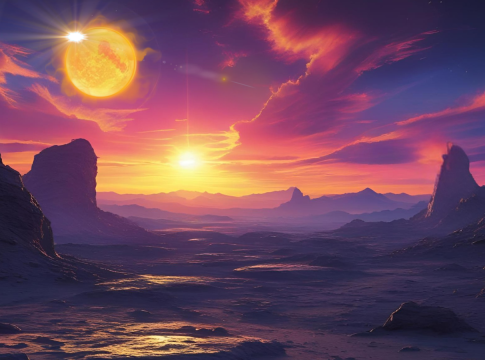Revolutionizing Astronomy: AI Program PHOEBAI Changes the Game for Binary Star Systems
A Leap in Efficiency with AI
In an exciting development for astrophysics, a new artificial intelligence system named PHOEBAI is poised to transform our understanding of binary star systems. Traditionally, analyzing these celestial twosomes could take a grueling month. However, with this innovative program, researchers can now accomplish the same task in a mere 10 minutes.
To put this rapid advancement into perspective, Villanova University researcher Andrej Prša, who co-authored the study, explains that the previously labor-intensive calculations required upwards of two weeks on a high-performance supercomputer. Now, those computations can be executed on a standard laptop in mere seconds, reshaping the landscape of stellar analysis.
Why Binary Stars Matter
More than 50% of sun-like stars and most massive stars are found in binary or multiple star systems. Understanding their characteristics—specifically their masses and sizes—offers critical insights into stellar evolution and dynamics. This data isn’t just academic; it has practical implications for our comprehension of the universe.
When viewing distant stars, especially those that eclipse one another, discerning their individual properties can be extremely challenging. The light from two overlapping stars often appears as a single point, complicating the task for astronomers. This is where PHOEBAI steps in, leveraging AI to analyze light patterns and effectively “untangle” the data from these binary systems.
Breaking Down the Technology
PHOEBAI employs a sophisticated neural network architecture that serves as a direct successor to an existing physical model known as PHOEBE. By harnessing tens of millions of artificially generated data points, PHOEBAI acts as a virtual "emulator" that can process astronomical data at an astonishing speed while maintaining high accuracy levels.
“By assuming the binary nature of star systems is already established, we focus on analyzing observations to extract fundamental stellar parameters,” says Prša. The AI effectively replaces traditional computational approaches that can be time-consuming and costly.
Wider Implications for Astronomy
The potential impact of PHOEBAI extends beyond speed alone. Researchers estimate that the ability to analyze hundreds of thousands of binary stars will significantly advance stellar population studies. Notable astronomical missions, including NASA’s TESS (Transiting Exoplanet Survey Satellite) and Kepler, are ideally positioned to benefit from this breakthrough.
Prša anticipates that the next year will herald a paradigm shift in the field, potentially expanding the pool of solved binaries from several hundred to hundreds of thousands. “This will be like opening a treasure trove for stellar research,” he stated.
Looking Ahead
As the team prepares for initial results on 150,000 eclipsing binary star light curves, they are also validating the AI to ensure accuracy and reliability. Once findings are finalized, they will be shared with both the scientific community and the public through peer-reviewed publications.
This leap in technology represents not just a significant breakthrough in the field of astrophysics but also exemplifies how AI continues to unlock increasingly complex challenges in science. With systems like PHOEBAI, we stand on the brink of a new era in understanding the cosmos—a testament to the transformative power of artificial intelligence.

Writes about personal finance, side hustles, gadgets, and tech innovation.
Bio: Priya specializes in making complex financial and tech topics easy to digest, with experience in fintech and consumer reviews.

